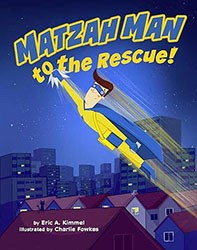There are many different ways to be foolish, and plenty of foolish Jews, but there is only one Chelm. In Right Side Up: Adventures in Chelm, master Jewish storyteller Eric Kimmel has performed a literary feat which the inhabitants of Chelm would appreciate. He has preserved the traditional flavor of the legendary tales, while updating the less-than-brilliant characters and their dilemmas. The people of Chelm may not have been able to figure out how to make buttered bread land right side up, but they knew how to appreciate the out-of-the-box approach to problems which Kimmel’s characters attempt with hilarious persistence.
As Kimmel explains in his “Author’s Note,” in his latest interpretation of these folktales “The original Chelm stories reflected their time. So should ours.” This community of kind but confused individuals includes a woman mayor and rabbi, as well as diverse casting in Steve Brown’s appealing pictures of a multicultural Chelm. Kimmel also jokes about cell phones and laptops, gently pointing out that in the old days, people had no such luxuries of instant communication. When Raizel the shulklapper (synagogue knocker) called people to prayer in Chelm, she had to knock loudly on their doors. Yet these steps into the modern world are only the beginning of Kimmel’s inventiveness in bringing Chelm back to life for middle grade readers.
In the book’s twelve chapters, the author combines accounts of the innocently irrational with ones suggesting that the rest of the world’s approach to problem solving may, in fact, be less productive than the Chelm method. A chapter about swimmers in Lake Chelm, who fail to distinguish whose feet belong to whom, is pure entertainment; as is the circular reasoning of a young couple paralyzed by the fear that a large rock may roll into a house which they have not yet built.
Other chapters explore material which has as much midrash as mishigas. Raizel’s task of awakening Jews for prayer — before cell phones — at the appointed time becomes challenging when it snows. Chelm residents enjoy the serene beauty of winter; snow is too beautiful to disturb even with the footprints of the shulklapper. Since Raizel’s solution involves knocking on doors off-schedule, Rabbi Devora needs to make a decision according to Jewish law: is it acceptable to pray at the “wrong” time? Kimmel’s narrator advocates for an adaptive and sensitive view of legal codes: “Some people wondered if this was proper…But that’s how they do it in Chelm.”
The book’s final chapter is the most theologically challenging, particularly for young readers immersed in a series of comic mishaps with happy resolutions. In “Zakkai Goes to Heaven,” the oldest person in the town meets the Angel of Death. Convinced that his days on earth are ending, the old man searches for Heaven, and becomes confused at its resemblance to Chelm. Kimmel turns a sad portrait of a flustered old man who has lost his eyeglasses into a comforting assertion about what matters most in life: “I don’t need them anymore. God has shown me the way.”
Emily Schneider writes about literature, feminism, and culture for Tablet, The Forward, The Horn Book, and other publications, and writes about children’s books on her blog. She has a Ph.D. in Romance Languages and Literatures.





